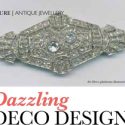The style we now call Art Deco was not known by that name until the term was coined in the 1960s. This sleek style of the 1920s and 1930s was called the Art Moderne or the Jazz style in its day. Its gestation period included the watershed event World War I (1914-1918).
Prior to this war, elegance, grandeur and luxury characterised the Edwardian period and was made manifest by the style and character of King Edward VII. World War I destroyed all of that and the survivors of the horrors of the war were ready to “live and forget the past”. Pre-war fashion, traditions and values were cast aside. Women were asked to take on male roles during the war; after the war they left behind their constricting corsets and traditions. They were emancipated; their hair cut short, hem lengths shortened and they wore trousers.
This was part of a wider liberation of society led by artists, jewellers, sculptors and architects. Everyday items took on the new design. They were decorated to look attractive and fashionable, bright and bold. It was a reaction against Art Nouveau and its naturalistic organic fluidity of the curve, muted colours and use of organic components. Art Deco embraced new and contrasting materials, straight clean lines and angles and even abstract patterns. Synthetics and plastics were incorporated, as they were new and novel …
Download the full article here to learn more about the jewellery in Baz Luhrmann’s movie “The Great Gatsby”

